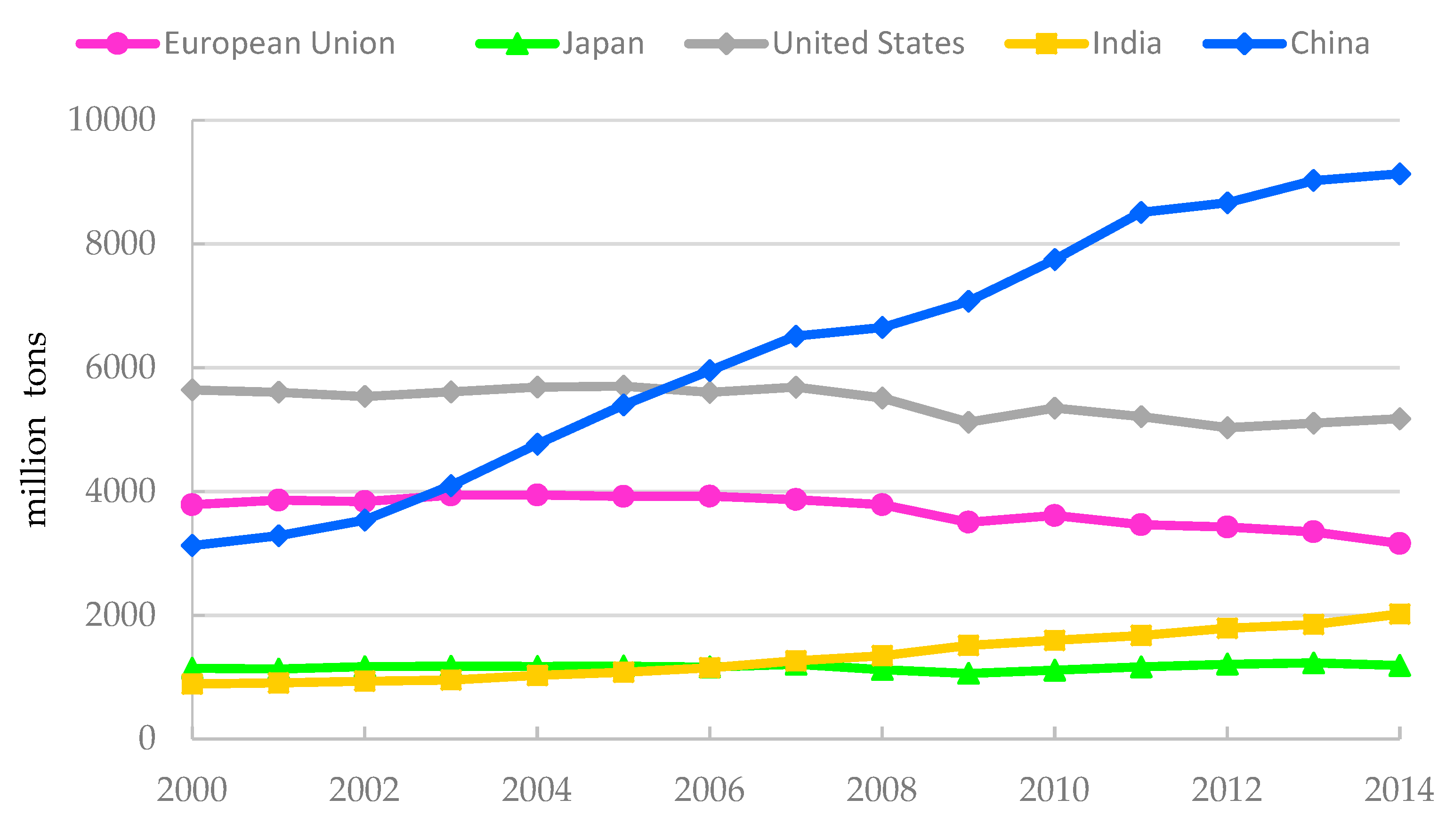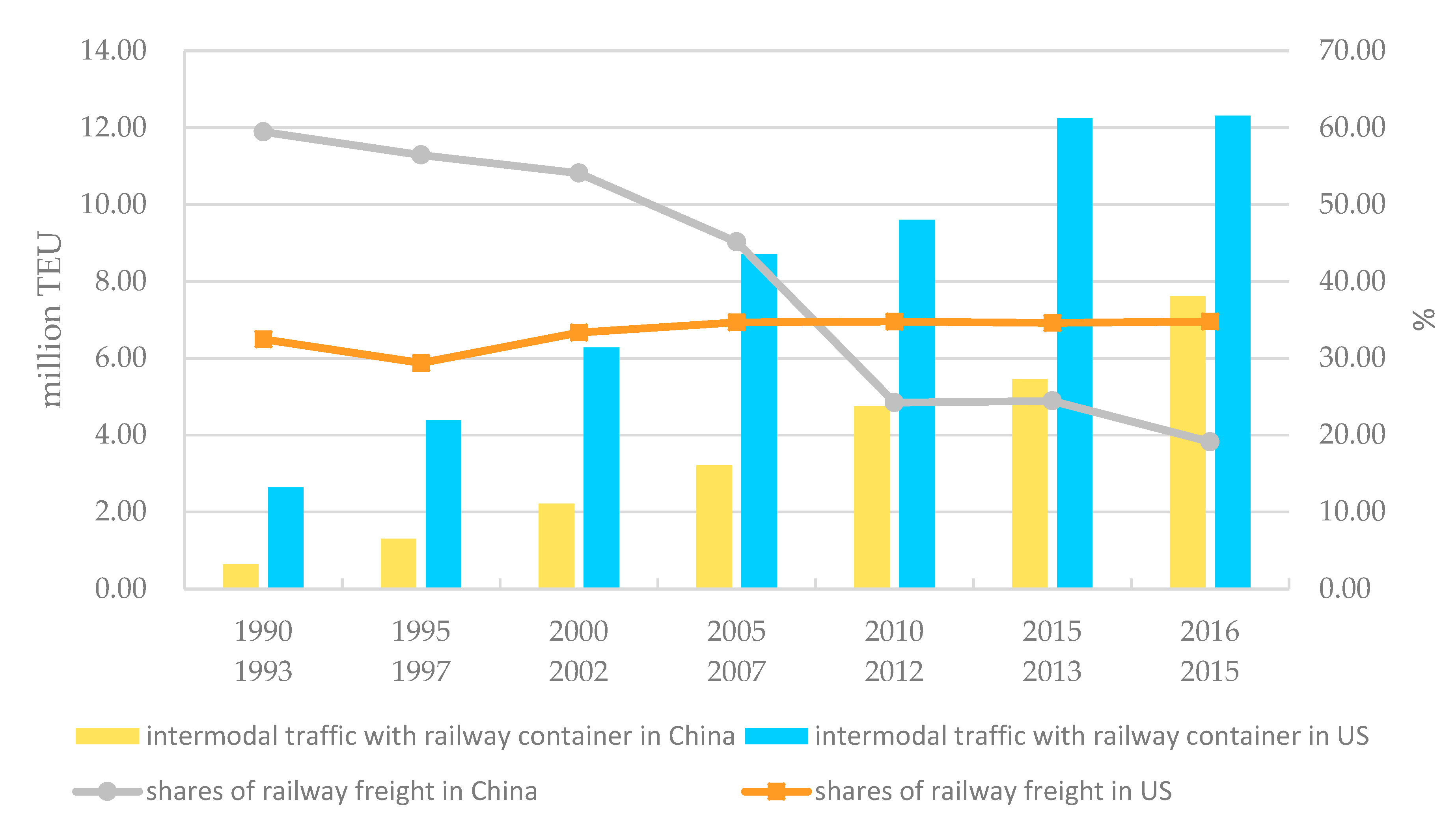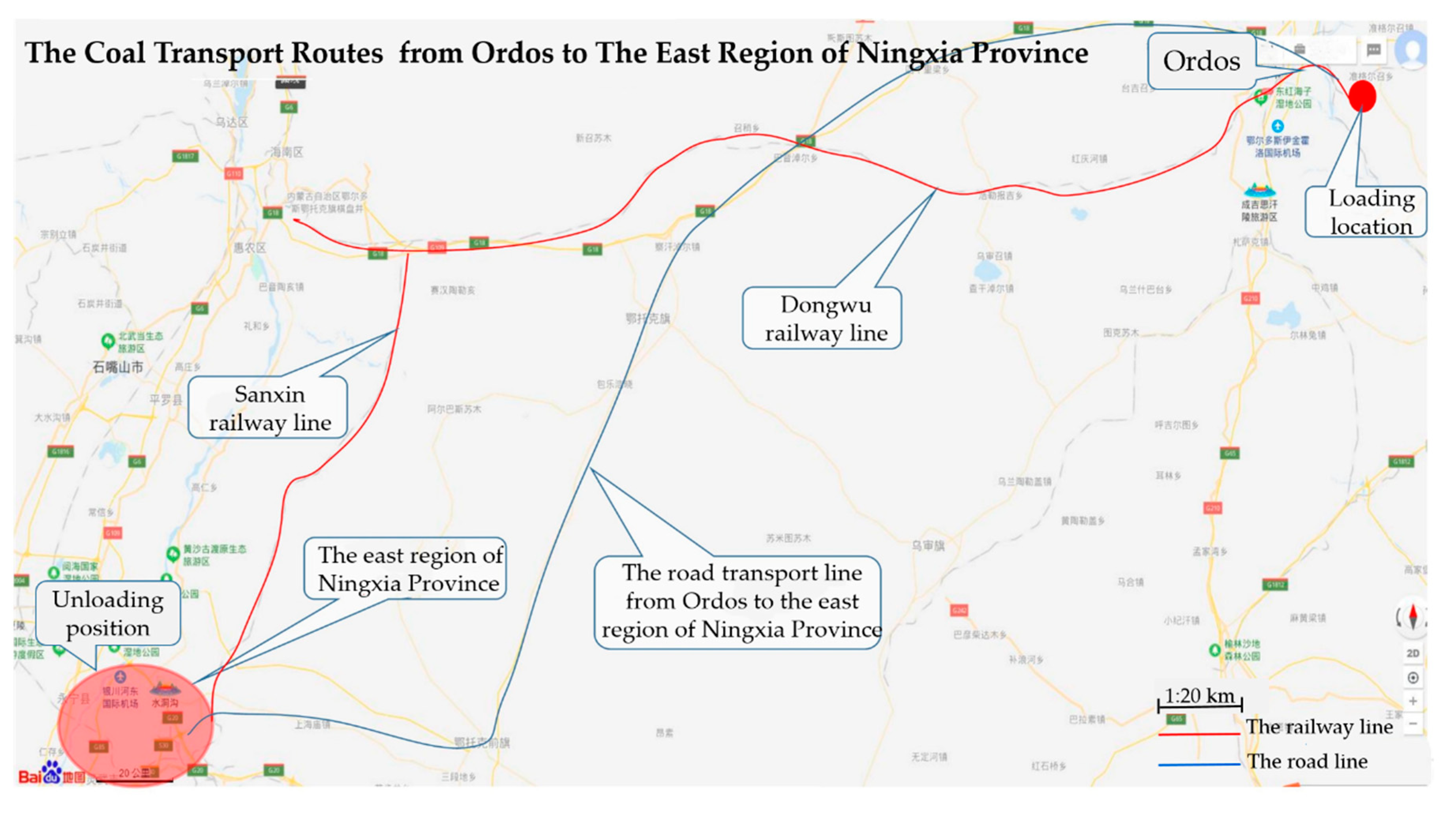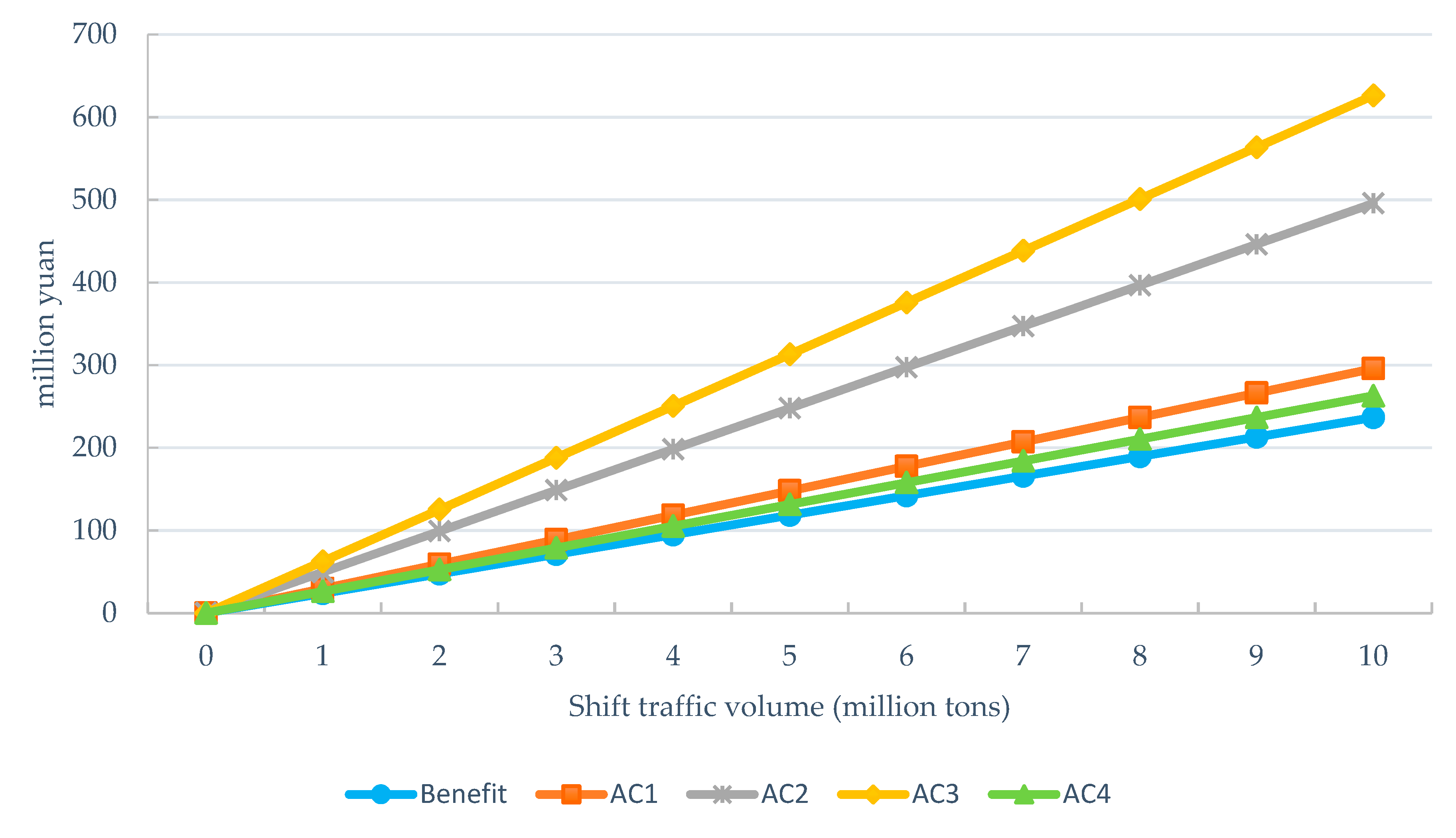6.1. Cost-Benefit Analysis of the Policy
In order to simplify the analysis and facilitate discussion, the environmental protection benefits in this paper mainly consider energy conservation and emissions reduction. Considering the current market situation and the actual losses caused by the policy, the costs of the policy are about three aspects, which are the losses of ports companies and road logistics enterprises, the investment in new railway projects, and the additional logistics costs. The benefits and costs of the modal shift from road to rail (“Road to Rail” policy) are defined as follows:
is the corresponding energy price, is the amount of energy saved; is the unit price of carbon emissions control, is the reduction amount of carbon emissions; is the benefit from safety; is the benefit from reduction of road congestion; is the benefit from reduction of additional road investment and land use (In China, the land occupied by rail for undertaking one traffic unit is 1/19 of that of road. Meanwhile, this ratio is 1/5 in US. So, when road capacity is short, implementing the “Road to Rail” policy can generate land use value); is the operating financial loss caused by the policy for ports companies and road logistics enterprises; is the new investment and operating costs for new railway projects to increase capacity; is the additional item related logistics costs due to longer transport time, short-term incapacity delay, intermediate costs; is service-related cost due to a lower service levels and is the social cost; π is the net benefit of the “Road to Rail” policy, which is equal to the total benefits minus total costs.
Take the coal transport in Ordos, Inner Mongolia as an example to analyze the benefits and costs caused by the modal shift policy. The effects of “Road to Rail” policy are obvious in Ordos. In 2017, the sales volume of coal in Ordos was about 602.46 million tons, and the railway traffic volume was about 333.64 million tons, which accounted for 55.38%. In 2018, the sales volume of coal in Ordos was about 663.72 million tons, and the railway traffic volume increased to 373.22 million tons, whose proportion was 56.23%. The total sales volume of coal increased by 61.26 million tons, and railway traffic increased by 39.58 million tons. The increase in railway traffic volume exceeded the increase in sales volume of coal. See as following, the railway coal transport line and road transport line from Ordos to the east region of Ningxia Province are shown in
Figure 3.
There are 350 coal mines with an annual output of more than 1.5 million tons in Ordos. For the target to shift traffic from road to rail, Inner Mongolia Autonomous Region “Three-year action plan for Road to Rail” required that more than 80% coal mines with an annual output of more than 1.5 million tons would have railway industrial siding by the end of 2020 [
34]. It means that Ordos will play an important role in the implementation of “Road to Rail” policy. In 2018, the traffic volume of coal shifted from road to rail is about 4 million tons in Ordos. We take the coal transport route from Ordos to East of Ningxia Province as an example to estimate the benefits and costs brought by the modal shift policy. The distance of road from Ordos to East of Ningxia Province is 450 km, and that is 510 km of railway. Due to the data availability, we mainly consider the benefits of energy saved and emissions reduction, and the costs of additional logistics cost by “Road to Rail” and new investment and operating costs for new railway projects.
6.2. The Effects of “Road to Rail” Policy: A Case in Ordos Region
The benefits brought by the policy are energy conservation and emissions reduction. We can calculate the energy consumption and carbon emissions for road and railway transport respectively when we take the coal transport route from Ordos to East of Ningxia Province as an example. The energy consumption and carbon emissions are calculated in
Table 11.
In
Table 12, the energy saving and emissions reduction effects brought by the modal shift in Ordos is that the energy consumption reduction is 68,817.48 TOE (It is approximately 98,312.65 tons of standard coal (1 TOE = 1.4286 tons of standard coal.)) and carbon emissions reduction is 126,960 tons. According to data from China Coal Resource Network, the annual unit averaged price of thermal coal with 5500 calories was 653.07 CNY in 2018, then the unit price of standard coal with 7000 calories was 831.18 CNY. The price for unit carbon emissions is different in China. There are seven major trading markets for carbon emissions in China, which are Beijing, Tianjin, Shanghai, Hubei, Guangzhou, Shenzhen, and Chongqing, and most of them are in the economic developed area or southeast coastal area. Ordos is located in the north-west region of China, and the “Road to Rail” policy is mainly for controlling the air pollution in Beijing. Thus, we used the price of Beijing Environment Exchange in 2018 to estimate the carbon emissions price in Ordos. From the website of Beijing Environment Exchange, the volume of carbon emissions in 2018 was 3,320,406 tons, and the turnover was 187,817,002.5 CNY, then we get the average price of carbon emissions was about 56.56 CNY (
https://www.bjets.com.cn/article/jyxx/). As a result, the total environmental benefit brought by the modal shift policy was about 94.68 million CNY. The unit benefit from road safety improvement was 0.00321 CNY for per ton-kilometer, which is the standard regulated by Ministry of Housing and Urban-Rural Development of the People’s Republic of China (According to the “Case of economic evaluation of construction project” in 2006, the Ministry of Housing and Urban-Rural Development of the People’s Republic of China made the safety losses standard for road transport. The safety losses of road is 0.00321 CNY for per ton-km, and it assumes no incidents on railway).
The costs of modal shift policy are mainly about the losses of ports and road freight enterprises, the investment cost of new railways, and additional social logistics costs. And the investment costs and social logistics costs are the long-term costs for the modal shift policy. For the availability of data, we mainly consider the investment costs and additional logistics costs in this paper. The cost of railway construction in Ordos varies from region to region, which is about 40 million CNY per kilometer in the eastern region and about 30 million CNY per kilometer in the central and western regions. A large number of railway projects need to be built in Inner Mongolia as the requirement of government, and the investment costs will become an important part of the policy.
The modal shift policy caused the traffic volume to shift from road to rail, which also increased freight rates and social logistics costs. We take the coal transport route from Ordos to East of Ningxia Province as an example to analyze the costs caused by “Road to Rail” policy. In the east region of Ningxia Province, the power plant needs coal as thermal coal to generate electricity, and the power plant has an industry railway line. In order to analyze the difference between with and without industry line, we set different scenarios to compare the costs.
(a) With one existing industry line linking one end of the railway trunk line
As shown in
Table 13, with one industry line linking one end of the railway line, the railway freight transport cost of coal from the Dongsheng of Ordos to the east region of Ningxia Province is about 149.58 CNY per ton, because it can save a fee of short-distance road transport and loading or unloading with 20 CNY. While the road freight is about 120 CNY. In 2018, the coal shift volume was 4 million tons in Ordos. Then, the total transport cost of the road was 480 million CNY, and that was 598.32 million CNY for railway. Compared with the road, the transport cost of railway increased by 24.65%. The additional logistics cost was about 118.32 million CNY, which is as much as more than 1.25 times of the total environmental benefits brought by the modal shift policy, which was 94.68 million CNY based on the previous calculation.
(b) Without industry line in both ends of the railway trunk lines
Without industry line in both ends of the railway line, the railway freight rates of coal transport from the Dongsheng of Ordos to the east region of Ningxia Province is about 169.58 CNY per ton, and total transport cost of the railway is 678.32 million CNY, which increased by 41.32% compared with road. The additional logistics cost is about 198.32 million CNY, which is as much as more than 2.09 times of the total benefits brought by the road to the railway. The freight rates are shown in
Table 14.
(c) Building a new railway (industry) line for 1.5 million tons initial traffic volume
For the requirement of the central government policy, all the companies with an annual bulk product output of more than 1.5 million tons need to construct railway industry line. The investment cost and operation cost for new railway industry line are the long-term and main costs for the modal shift policy. Given the fact that the power plant in the east region of Ningxia Province has an industry line system already, suppose only one new railway (industry) line in Ordos. We take Dongsheng–Wuhai and Baotou–Lanzhou linking line in
Table 15 as an example to estimate the unit cost of new railway industry line. Its mileage is about 23 km and its unit construction cost is about 47 million CNY/km.
Based on the reality, 30% of the construction cost of new railway industry line comes from capital and 70% comes from bank loans. The annual interest rate of bank loan is about 6%, and the annual comprehensive depreciation rate for railway asset is 3%. Thus, we can see the costs in
Table 16 that the capital is about 14.1 million CNY, and bank loan is about 32.9 million CNY. Moreover, the annual interest cost is about 1.974 million CNY, and the annual depreciation cost is 1.41 million CNY.
The requirement of government is that the coal mines with an annual output of more than 1.5 million tons should construct new railway industry line. We consider two scenarios to analyze the operation cost for new railway industry line: the initial traffic volume is 1.5 million tons and the initial traffic volume is 5 million tons. The unit transport cost for new railway industry line for 1.5 million tons is shown in
Table 17.
As shown in
Table 18, with new industry line for 1.5 million tons initial traffic volume, the railway freight rate of coal transport from the Dongsheng of Ordos to the east region of Ningxia Province is about 182.62 CNY per ton, and the road freight is about 120 CNY. The total transport cost of railway was 730.47 million CNY in 2018 in Ordos. Compared with the road, the transport cost of railway increased by 52.18%. The additional logistics cost is about 250.47 million CNY, which is as much as more than 2.65 times of the total environmental benefits brought by the modal shift policy.
(d) Building a new railway (industry) line for 5 million tons initial traffic volume
When the initial traffic volume is 5 million tons for new railway industry line, the full freight rate for industry line is three times lower than that with 1.5 million tons. The total railway freight rate is about 146.30 CNY. In this scenario, the total transport cost of railway is 585.19 million CNY, which increased by 21.91% compared with road. The additional logistics cost is about 105.19 million CNY, which is as much as more than 1.11 times of the total environmental benefits brought by the modal shift policy. The unit transport cost of new railway industry line for 5 million tons can been seen in
Table 19, and the freight rates of coal transport with new industry line for 5 million tons initial traffic volume from Ordos to East of Ningxia Province can been seen in
Table 20.
The full freight rate equals the break-even freight rate multiplied by 23 km, and its unit is CNY/ton.
The additional cost in four scenarios is different, and the highest cost is to construct new railway industry line with initial traffic volume 1.5 million tons. As shown in
Figure 4, the costs caused by modal shift policy in four scenarios are all higher than the benefits brought by the policy. The most effective method of implementing “Road to Rail” policy is to construct new railway industry line when the initial traffic volume is large enough, but the cost is expensive if the initial traffic volume is insufficient, such as 1.5 million tons. When the initial traffic volume is small, the railway with industry line is suitable and cost-effective for shifting the traffic volume from road. The railway without industry line will cause large additional transport cost losses.
According to the previous calculation, we get the slope of benefit line is 23.67, and the slope of AC4 (additional cost, AC4 is the additional cost with railway industry line for 5 million tons initial traffic volume) line is 26.3. With the shift traffic volume increasing, the benefit is always lower than AC4, which indicates the policies will lead to economic losses when achieving environment goals. The slope of benefit line depends on the unit price of carbon emissions, which is lower in China. In this paper, we use the price 56.56 CNY of Beijing Environment Exchange in 2018. If we use the 2015 World Bank economic price for carbon emissions of US dollar 30 per ton [
35], then the slope would be larger than 27.58. It means that the benefits will exceed the AC4, and the policy can balance the economic growth and environment protection. However, the carbon emissions trade market in China is imperfect, and the market underestimates the price of carbon emissions.
Moreover, the road transport is more flexible and convenient. The railway not only needs to ask for the wagons and coordinate the vehicles, but also needs to guarantee large traffic volume. If the traffic volume is not stable and sufficient, it is more difficult to coordinate the vehicles for the consignors. Furthermore, the additional costs do not include the loss of ports companies and road logistics enterprises, the loss due to a lower service levels, and the social cost for inefficiency. If these costs are taken into consideration, the costs caused by policy will be larger. According to the current situation (the initial traffic volume of most coal miners is small and insufficient), the “Road to Rail” policy is more suitable for railways with industry lines in the ends.
In general, the current modal shift policies have had negative impacts on the economic development when they achieved environmental goals. Therefore, ensuring economic growth and taking environmental goals into account is a key point of the modal shift policy. The market tools to achieve modal shift are to be considered, and simply relying on administrative means will inevitably lead to economic inefficiency. Policies that only consider environmental protection goals and do not pay attention to economic effects will face many problems in the implementation process.








